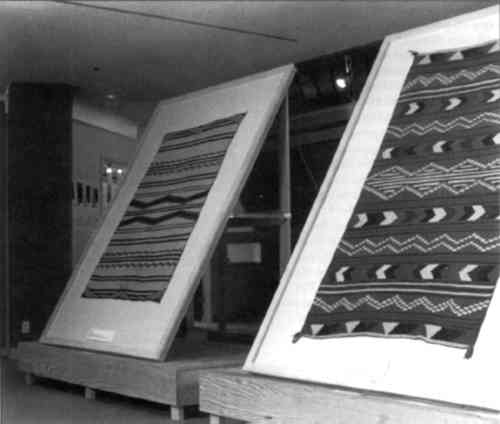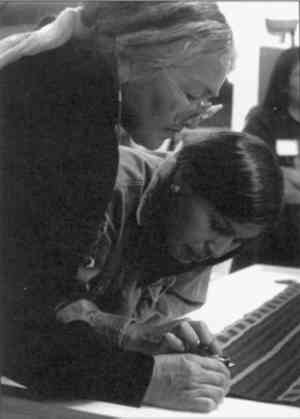WOVEN BY THE GRANDMOTHERS: TWENTY-FOUR BLANKETS TRAVEL TO THE NAVAJO NATIONSUSAN HEALD, & KATHLEEN E. ASH-MILBY
3 CONSERVATION CONCERNSThe conservator's role in the project was to reduce the risk of damage to the blankets while they were in Tsaile. This responsibility included assessing the condition of the blankets prior to travel, working with NMAI's Exhibitions Department to develop mounts, installing the textiles on site, and acting as a “handler” during the workshop. Hands-on access to the textiles was integral to the workshop; participants would be allowed to closely examine weaving details. The importance of handling and examining these textiles by Navajo weavers is similar to that of curators and scholars examining art objects in other museum collections. A notable difference is the close spiritual connection many Native people feel toward their cultural material. While the Conservation Department fully supported the museum's outreach goals, the conservator was apprehensive about placing collection objects at risk during these events. The reality of working in a museum like NMAI means the conservator's priority is to protect objects such as these textiles for Native people, not from them; preservation and access must go hand-in-hand. Both NMAI and Hatathli Museum staff were sensitive to these issues. Everyone involved worked together to minimize the risk of damage without hampering the objectives of the project. 3.1 CONDITION OF THE TEXTILESOf the original blankets selected for travel, several had to be excluded because of structural weakness from wear and in some cases severe insect damage. In these cases more stable substitutes were chosen. Fortunately, many of the textiles had been recently treated and stabilized by outside contract conservators. One textile (9.1910), a woman's manta or shoulder blanket dated to about 1860, exhibited areas of weakness on two edges including weft loss exposing the warps and abraded selvage cords. The damage appeared to be from wear, not insect damage. While these areas had been stabilized, they were still vulnerable to damage if handled. However, both Bonar and Begay felt this piece would be especially significant to contemporary weavers because it was a typical blanket that showed signs of wear. It was interesting because of its overall twill tapestry structure and simple design. Damaged areas also revealed structural details. For instance, one side of the blanket had blue warps, the other side white; lacing details at the warp turns were also visible. After some consideration, this piece was allowed to travel on the condition that it be carefully monitored during the loan. Some of the textiles had minor insect damage from previous infestations. In some natural history and ethnographic collections, past use of residual pesticides such as arsenic and mercury compounds presents a hazardous handling situation. Most often these pesticides were used on taxidermy specimens or furs, but sometimes on textile materials as well (Hawks and Williams 1986). There is no recorded history of any such residual pesticides being used on textiles in the collection. The Conservation Department continually tests suspicious residues when found. To date, all test results have been negative. Therefore, we felt handling of these textiles did not pose a danger to staff or participating weavers. 3.2 MOUNTING STRATEGYUnlike most museum exhibitions where mounts are used solely for display, this project required mounts for both exhibition presentation and workshop support (but not for travel). Conservation requirements included the following: the textiles had to be displayed flat and fully supported and the mounts had to minimize handling during the installation and the workshop. The NMAI exhibitions staff designed elegant, lightweight slant boards that were fabricated quickly and inexpensively in three standard sizes (fig. 2). Because the blankets were mounted for only nine days, conservation standards for materials were relaxed to some extent. For example, wood products were not coated, and Gatorfoam was used instead of a more archival material.
The Gatorfoam boards were covered with an undyed cotton fabric attached with poly (vinyl acetate) adhesive. Poplar wood trim was used to frame the covered boards. A hinged plywood gateleg attached along the upper back edge allowed the entire mount to fold flat easily. An aluminum side brace attached to the frame locked the gateleg into place with the board at a 70� angle. The lightweight, folding-leg design enabled the mounts to support textiles during the workshop as well as in the exhibition. The mounts greatly minimized handling by acting as support boards in transporting the textiles from the gallery to the adjacent workshop room and by serving as horizontal examination surfaces when placed on tables (fig. 3). Blankets did not need to be removed from their mounts until they were rolled for crating at the end of the event.
It was disheartening to discover upon our arrival in Tsaile that about one-third of the mounts were damaged in shipping. The Gatorfoam was dented and in one case punctured, probably by a forklift. Additionally, some of the wood trim was separated or broken. We managed to salvage all but one mount, forcing us to eliminate only one textile from the display. We were, however, still able to make this blanket available during the workshop. Textiles were fastened to the slant boards by pinning along the upper edge and sides with stainless steel insect pins. This strategy was chosen so that all areas of the front and back would be visible for examination; other systems such as Velcro or pinning bands stitched to the back would have covered part of the textile. After pinning the blankets to the slant boards, the mounts were placed on 1-ft.-high plywood platforms fabricated by the NCC woodshop. The platforms elevated the slant boards from the gallery floor, placing the textiles at eye level and creating a toe-edge that distanced the viewer slightly. No other physical barriers were used. During the installation NMAI staff worked with Hatathli Museum staff and trained high school volunteers in handling and mounting techniques. The extra help provided by the students was invaluable in setting up the gallery. Not only did they supplement our initial two-person installation team before the balance of the NMAI staff arrived, but they also were provided a unique opportunity to learn about museum work through firsthand experience. 3.3 TOUCHING AND SIGNAGE ISSUESShortly after the display opened to the public, it became clear that touching and signage issues needed to be reevaluated. It was the conservator's understanding that the public display was to be completely “hands-off,” while the workshop event was to be controlled and supervised “hands-on.” For the public display, some staff from both NMAI and the Hatathli Museum assumed that we would post “Please Do Not Touch” signs. Others felt that any physical barriers or signs would be intrusive to Navajo viewers. In traditional museum settings, some Native viewers feel distanced and alienated from their cultural heritage by such barriers. NMAI staff did not want to offend Navajo visitors, especially on the Navajo reservation, where we were guests. It was also assumed by some Navajo staff and advisers that “Please Do Not Touch” signs would be unnecessary because Navajo visitors simply would not touch out of respect. Initially NMAI staff and student volunteers were stationed around the gallery to ask people politely not to touch the textiles. It became immediately clear that many visitors did feel inclined to touch, and the verbal directions could be interpreted as insulting. One impassioned response was, “Why don't you have 'Do Not Touch' signs if you don't want us to touch!?” There was clearly a confusing double standard regarding the touching policy; workshop participants could touch, but other visitors could not. In discussions about the issue, one Hatathli Museum staff member suggested large “Do Not Touch” signs printed in red letters. To remedy the situation without drastic or intrusive measures, the following compromise was reached: four 8 � 10 in. signs that read, “Please Ask a Staff Member If You Want to Touch a Blanket,” were posted in several locations around the gallery. Additionally, small “Please Do Not Touch” signs were placed on each platform beneath the object labels. This placement allowed the viewers to see the sign as they approached the textiles and read the label copy. The 10 most stable and sturdy textiles were designated as “touchable” in the lower unpinned corners, and identified with a star on their labels. Upon request, staff led interested visitors to appropriate textiles that could be handled. In addition, greeters politely explained the handling policy (translated into Navajo when necessary) to visitors as they signed the guest book at the gallery entrance. Our new approach was well received, and the incidents of random handling became virtually nonexistent. Visitors did approach staff members asking to touch. This interaction between staff and visitors promoted discussions and questions concerning the blankets, display, and NMAI. Touching was always gentle and respectful: most visitors seemed only to want a brief physical connection with the weavings. |

